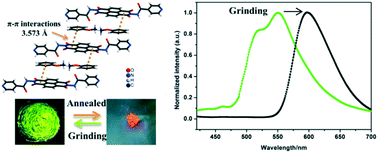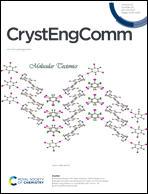A two-component molecular hybrid with enhanced emission characteristics and mechanoresponsive luminescence properties†
Abstract
Mechanoresponsive luminescent materials refer to materials exhibiting luminescence intensity and/or color change in the solid-state induced by external mechanical stimulation and are attracting considerable attention for their potential applications in many fields. For organic molecular materials, the mechanoresponsive luminescence phenomenon can significantly depend on the molecular packing modes and orientations of individual fluorophores, enabling the development of molecular materials with mechanoresponsive luminescence characteristics. Naphthalene diimides (NDIs) are well-known organic dyes with an electron-deficient plane, making them excellent candidates for exploring mechanoresponsive luminescence properties owing to their photophysical and photochemical properties that depend on the packing modes and are very sensitive to the micro-environment. In this work, a new binary charge transfer cocrystal complex with sensitive mechanoresponsive luminescence, IsoNDI·anisole (C1) (IsoNDI = N,N-di(4-pyridylacylamino)-1,4,5,8-naphthalene diimide), was designed and prepared. C1 shows interesting enhanced emission characteristics and reversible mechanochromic luminescence properties with a prominent color change from orange to bright green-yellow by mechanical grinding. This study demonstrates that the development of new mechanoresponsive luminescent materials through donor–acceptor interactions is an effective avenue.

- This article is part of the themed collection: Supramolecular & Polymorphism


 Please wait while we load your content...
Please wait while we load your content...